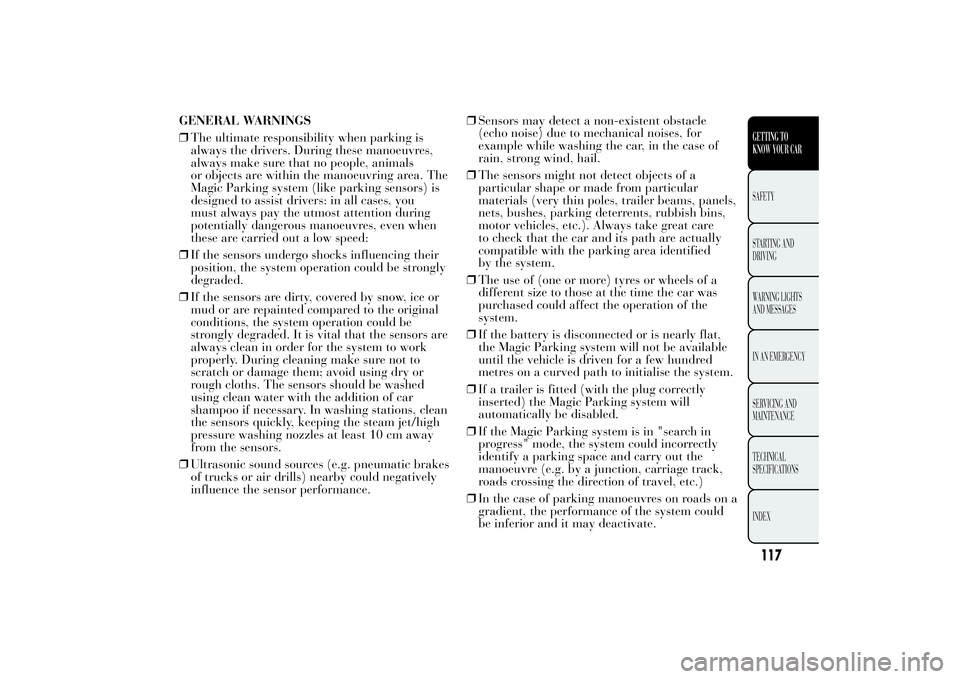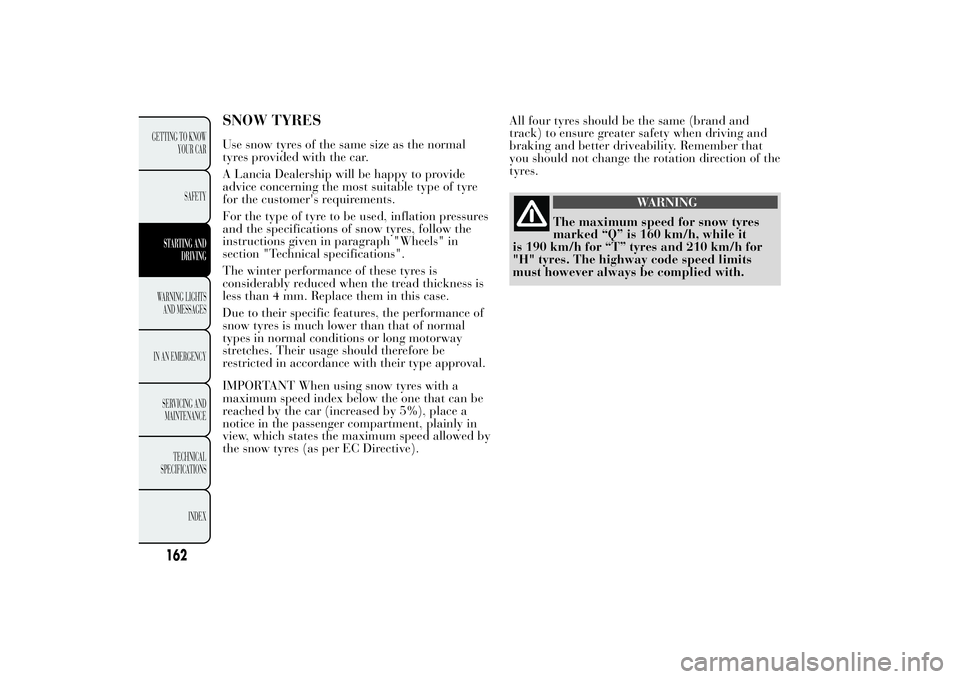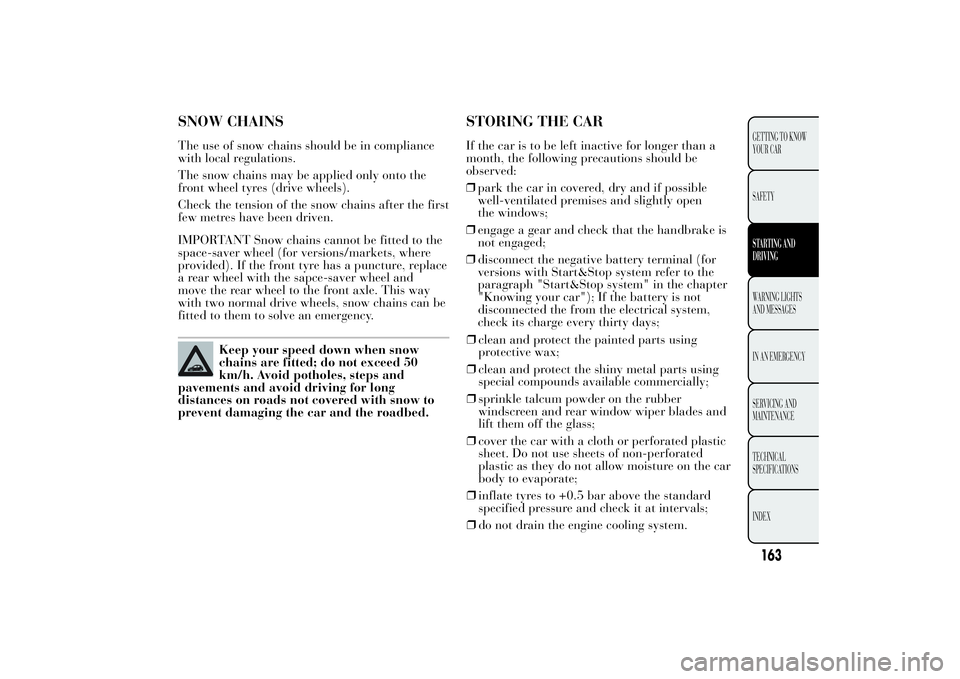wheel Lancia Ypsilon 2014 Owner handbook (in English)
[x] Cancel search | Manufacturer: LANCIA, Model Year: 2014, Model line: Ypsilon, Model: Lancia Ypsilon 2014Pages: 315, PDF Size: 13.18 MB
Page 121 of 315

GENERAL WARNINGS
❒The ultimate responsibility when parking is
always the drivers. During these manoeuvres,
always make sure that no people, animals
or objects are within the manoeuvring area. The
Magic Parking system (like parking sensors) is
designed to assist drivers: in all cases, you
must always pay the utmost attention during
potentially dangerous manoeuvres, even when
these are carried out a low speed:
❒If the sensors undergo shocks influencing their
position, the system operation could be strongly
degraded.
❒If the sensors are dirty, covered by snow, ice or
mud or are repainted compared to the original
conditions, the system operation could be
strongly degraded. It is vital that the sensors are
always clean in order for the system to work
properly. During cleaning make sure not to
scratch or damage them; avoid using dry or
rough cloths. The sensors should be washed
using clean water with the addition of car
shampoo if necessary. In washing stations, clean
the sensors quickly, keeping the steam jet/high
pressure washing nozzles at least 10 cm away
from the sensors.
❒Ultrasonic sound sources (e.g. pneumatic brakes
of trucks or air drills) nearby could negatively
influence the sensor performance.❒Sensors may detect a non-existent obstacle
(echo noise) due to mechanical noises, for
example while washing the car, in the case of
rain, strong wind, hail.
❒The sensors might not detect objects of a
particular shape or made from particular
materials (very thin poles, trailer beams, panels,
nets, bushes, parking deterrents, rubbish bins,
motor vehicles, etc.). Always take great care
to check that the car and its path are actually
compatible with the parking area identified
by the system.
❒The use of (one or more) tyres or wheels of a
different size to those at the time the car was
purchased could affect the operation of the
system.
❒If the battery is disconnected or is nearly flat,
the Magic Parking system will not be available
until the vehicle is driven for a few hundred
metres on a curved path to initialise the system.
❒If a trailer is fitted (with the plug correctly
inserted) the Magic Parking system will
automatically be disabled.
❒If the Magic Parking system is in "search in
progress" mode, the system could incorrectly
identify a parking space and carry out the
manoeuvre (e.g. by a junction, carriage track,
roads crossing the direction of travel, etc.)
❒In the case of parking manoeuvres on roads on a
gradient, the performance of the system could
be inferior and it may deactivate.
117GETTING TO
KNOW YOUR CARSAFETY
STARTING AND
DRIVING
WARNING LIGHTS
AND MESSAGES
IN AN EMERGENCY
SERVICING AND
MAINTENANCE
TECHNICAL
SPECIFICATIONS
INDEX
Page 122 of 315

❒If a parking manoeuvre is being carried out
between two parked vehicles alongside the
pavement, the Magic Parking system may cause
the car to mount the pavement.
❒Some manoeuvres at very tight bends may not
be carried out.
❒Take great care to ensure that conditions do not
change during the parking manoeuvre (e.g. if
there are persons and/or animals in the parking
area, moving cars, etc.) and intervene
immediately if necessary.
❒During parking manoeuvres, pay attention to
cars approaching from the opposite direction.
Always follow the Highway Code.
IMPORTANT Correct system operation is not
guaranteed if snow chains or emergency wheels
are fitted.
IMPORTANT The correct positioning of the car
inside the parking space detected by the system
depends on various factors, in particular the
circumference of the wheels. For example,
if wheels with a 14" diameter are fitted, the
position of the car inside the parking area could
be slightly different.MESSAGES ON THE DISPLAY
Search in progress:the Magic Parking system is
searching for a suitable parking space.
Parking found:the Magic Parking system has
found a suitable parking space.
Drive forward:the Magic Parking system
requests the driver to proceed slowly to bring the
car to the correct position before starting the
semi-automatic manoeuvre or, during the
semi-automatic manoeuvre, the system requests
the driver to engage the forward gear to continue
the manoeuvre.
Engaging reverse:a suitable parking place has
been found and the position is correct for starting
the parking manoeuvre. Stop and engage reverse.
Disengage reverse:when the Magic Parking
activation button is pressed, reverse gear must be
released for the system to be switched on.
Magic Parking: steering wheel being usedThe
manoeuvre is about to begin, the driver is
requested to release the steering wheel.
Drive backwards - Magic Parking: steering
wheel being used:The manoeuvre has started,
the driver can accelerate and release the clutch (in
the case of a manual gearbox) to enter the parking
space. The system manages the steering
automatically.
118GETTING TO
KNOW YOUR CAR
SAFETY
STARTING AND
DRIVING
WARNING LIGHTS
AND MESSAGES
IN AN EMERGENCY
SERVICING AND
MAINTENANCE
TECHNICAL
SPECIFICATIONS
INDEX
Page 123 of 315

Speed too high:The speed of the car is about to
exceed the maximum speed permitted by the
system (the message will be displayed at about 25
km/h for the search stage). If the speed is
increased further, the system will be deactivated
automatically.
Magic Parking not available:A problem has
been detected in the system. In this case, go to a
Lancia Dealership.
Try again later:The Magic Parking system has
detected a problem in one of the systems required
for its operation. If the problem persists, go to a
Lancia Dealership.
Action on the steering wheel:The driver has
voluntarily or involuntarily operated the steering
wheel. The system is disabled and the manoeuvre
is controlled by the driver again.
Magic Parking OFF:The system is deactivated
for one of the following conditions: manoeuvre
concluded, speed limits exceeded, presence of
a trailer, search stage too long, manoeuvre stage
too long, use of parking sensors requested during
the search stage, incorrect car trajectory as a result
of obstacles at the wheels.End Manually:
❒The initial parking stage managed by system
has ended, but the parking manoeuvre must
be completed by the driver.
❒The steering wheel has been grasped during the
manoeuvre.
❒Reverse gear has been disengaged during the
manoeuvre and the car has moved off.
❒Due to obstacles, the path followed by the car is
different from the one required for system
activation.
Trailer present:The system activation has been
requested, but the car has a trailer (the trailer
socket is correctly fitted).
Magic Parking deactivated:The system has
been deactivated following a request to activate
the parking sensors during the search stage with
the vehicle speed below 15 km/h.
IMPORTANT Some messages displayed are
accompanied by acoustic warnings.
119GETTING TO
KNOW YOUR CARSAFETY
STARTING AND
DRIVING
WARNING LIGHTS
AND MESSAGES
IN AN EMERGENCY
SERVICING AND
MAINTENANCE
TECHNICAL
SPECIFICATIONS
INDEX
Page 131 of 315

Emergency refuelling (only for versions
equipped with "Smart Fuel")
If there is no fuel in the car or the supply circuit is
completely empty, proceed as follows to
reintroduce fuel in the tank:❒open the luggage compartment and take the
adapter B located in the tool box (versions
equipped with space-saver wheel - for
versions/markets, where provided) fig. 89 or in
the Fix&Go Automatic container (versions
equipped with Fix&Go Automatic) fig. 90;
❒open the flap A pulling it outwards;
❒insert adapter B in the filler as shown in fig. 91
and refuel;
❒after refuelling, remove the adapter and close
the flap;
❒reintroduce the adapter in the box and put this
back in the luggage compartment.
fig. 89
L0F0242
fig. 90
L0F0241
fig. 91
L0F0086
127GETTING TO
KNOW YOUR CARSAFETY
STARTING AND
DRIVING
WARNING LIGHTS
AND MESSAGES
IN AN EMERGENCY
SERVICING AND
MAINTENANCE
TECHNICAL
SPECIFICATIONS
INDEX
Page 151 of 315

AIRBAGThe car is fitted with front airbags for driver and
passenger, front side bags for driver and passenger
chest-shoulder protection (for versions/markets,
where provided), and window bags for protecting
the heads of front occupants.
FRONT AIRBAGS
The front (driver and passenger) airbags protect
the front seat occupants in the event of head-on
impacts of medium-high severity, by placing
the bag between the occupant and the steering
wheel or dashboard.
Therefore non-deployment in other types of
impacts (side impacts, rear shunts, roll-overs, etc.)
does not indicate a system malfunction.
Front (driver and passenger) air bags are not a
replacement of but complementary to the seat
belts, which you are recommended to always wear,
as specified by law in Europe and most non-
European countries.
In the event of an impact, those not wearing a seat
belt move forward and may come into contact
with the bag which is still inflating. The protection
offered by the bag is reduced in these
circumstances.Front airbags may not activate in the following
situations:
❒frontal impacts against highly deformable
objects not involving the front surface of the car
(e.g. wing collision against guard rail, etc.);
❒car wedging under other vehicles or protective
barriers (e.g. trucks or guard rails);
they may not provide any additional protection
compared with seat belts, so their deployment
would be inappropriate. In these cases, non-
deployment does not indicate a system
malfunction.
WARNING
Do not apply stickers or other objects
on the steering wheel, on the
dashboard in the passenger side airbag area,
on side upholstery on roof and on the seats.
Never put objects (e.g. mobile phones) on the
passenger side of the dashboard since they
could interfere with correct inflation of
the passenger airbag and also cause serious
injury to the passengers.
147GETTING TO KNOW
YOUR CARSAFETYSTARTING AND
DRIVING
WARNING LIGHTS
AND MESSAGES
IN AN EMERGENCY
SERVICING AND
MAINTENANCE
TECHNICAL
SPECIFICATIONS
INDEX
Page 152 of 315

Driver side front airbag
This consists of an instantly inflating bag
contained in a special compartment in the centre
of the steering wheel fig. 108.
WARNING
Always drive keeping your hands on
the steering wheel rim so that the
airbag can inflate freely if necessary. Do not
drive with your body bent forward. Keep
your back straight against the backrest.
Passenger side front airbag
This consists of an instantly-inflating bag
contained in a special compartment in the
dashboard fig. 109: this bag has a larger volume
than that on the driver's side.
WARNING
SERIOUS DANGER: never place
cradle child seats facing backwards
on the front passenger seat of cars
with active passenger side airbag.
Deployment of the airbag following an
impact could cause fatal injuries to the
child. Always deactivate the passenger side
airbag when placing a child seat on the front
seat. The passenger seat must also be
positioned back as far as possible in order
to avoid the child seat from coming into
contact with the dashboard. Although this is
not mandatory by law, the airbag should
be immediately reactivated when children
are no longer transported to ensure better
protection for adults.
fig. 108
L0F0072
fig. 109
L0F0073
148
GETTING TO KNOW
YOUR CAR
SAFETY
STARTING AND
DRIVING
WARNING LIGHTS
AND MESSAGES
IN AN EMERGENCY
SERVICING AND
MAINTENANCE
TECHNICAL
SPECIFICATIONS
INDEX
Page 159 of 315

If, when the ignition key is at MAR the
warning light remains lit, turn the key to
STOP and then back to MAR; if the warning light
remains lit, try with the other keys provided
with the car.
Contact a Lancia Dealership if you still cannot
start the engine.
Warning light
will flash for 60
seconds after starting or during
prolonged cranking to indicate a fault
with the glow plug heating system. You can
use the car as usual if the engine starts but
you should contact a Lancia Dealership as
soon as possible.
WARNING
It is dangerous to run the engine in
enclosed areas. The engine takes
in oxygen and releases carbon dioxide,
carbon monoxide and other toxic gases.
WARNING
Remember that the brake servo and
power steering are not operational
until the engine has been started, therefore
much effort than usual is required on the
brake pedal and steering wheel.
155GETTING TO KNOW
YOUR CAR
SAFETYSTARTING AND
DRIVINGWARNING LIGHTS
AND MESSAGES
IN AN EMERGENCY
SERVICING AND
MAINTENANCE
TECHNICAL
SPECIFICATIONS
INDEX
STARTING PROCEDURE FOR DIESEL
VERSIONS
Proceed as follows:
❒engage the handbrake and place the gearbox in
neutral;
❒turn the ignition key to MAR: the warning lights
and
on the instrument panel will turn
on;
❒wait for the warning lights
and
to
switch off;
❒press the clutch pedal down to the floor without
touching the accelerator;
❒turn the ignition key to AVV as soon as warning
light
switches off. Waiting too long will
waste the work done by the glow plugs. Release
the key as soon as the engine starts.
IMPORTANT With cold engine, the accelerator
must be entirely released when turning the
ignition key to position AVV.
If the engine does not start at the first attempt,
return the ignition key to STOP before repeating
the procedure.
Page 161 of 315

Never leave children in the unattended car. Always
remove the ignition key when leaving the car and
take it out with you.
WARNING
The car should be braked after a few
clicks of the lever, if it is not, contact
a Lancia Dealership to have it adjusted.
157GETTING TO KNOW
YOUR CAR
SAFETYSTARTING AND
DRIVINGWARNING LIGHTS
AND MESSAGES
IN AN EMERGENCY
SERVICING AND
MAINTENANCE
TECHNICAL
SPECIFICATIONS
INDEX
PARKINGSwitch off the engine and engage the handbrake.
Engage a gear (first gear if parked uphill or
reverse if facing downhill) and leave the wheels
turned. If the car is parked on a steep slope block
the wheels with a wedge or stone. Always remove
the ignition key when leaving the car.
HANDBRAKE
To engage the handbrake pull lever A fig. 112
upwards until the car is secured. To release the
handbrake, raise the lever A slightly, press and
hold the button B and lower the lever.
If the car is parked on a steep slope, it is also
advisable to block the wheels with a wedge or
stone.
fig. 112
L0F0074
Page 166 of 315

All four tyres should be the same (brand and
track) to ensure greater safety when driving and
braking and better driveability. Remember that
you should not change the rotation direction of the
tyres.
WARNING
The maximum speed for snow tyres
marked “Q” is 160 km/h, while it
is 190 km/h for “T” tyres and 210 km/h for
"H" tyres. The highway code speed limits
must however always be complied with.
162
GETTING TO KNOW
YOUR CAR
SAFETY
STARTING AND
DRIVINGWARNING LIGHTS
AND MESSAGES
IN AN EMERGENCY
SERVICING AND
MAINTENANCE
TECHNICAL
SPECIFICATIONS
INDEX
SNOW TYRESUse snow tyres of the same size as the normal
tyres provided with the car.
A Lancia Dealership will be happy to provide
advice concerning the most suitable type of tyre
for the customer's requirements.
For the type of tyre to be used, inflation pressures
and the specifications of snow tyres, follow the
instructions given in paragraph "Wheels" in
section "Technical specifications".
The winter performance of these tyres is
considerably reduced when the tread thickness is
less than 4 mm. Replace them in this case.
Due to their specific features, the performance of
snow tyres is much lower than that of normal
types in normal conditions or long motorway
stretches. Their usage should therefore be
restricted in accordance with their type approval.
IMPORTANT When using snow tyres with a
maximum speed index below the one that can be
reached by the car (increased by 5%), place a
notice in the passenger compartment, plainly in
view, which states the maximum speed allowed by
the snow tyres (as per EC Directive).
Page 167 of 315

STORING THE CARIf the car is to be left inactive for longer than a
month, the following precautions should be
observed:
❒park the car in covered, dry and if possible
well-ventilated premises and slightly open
the windows;
❒engage a gear and check that the handbrake is
not engaged;
❒disconnect the negative battery terminal (for
versions with Start&Stop system refer to the
paragraph "Start&Stop system" in the chapter
"Knowing your car"); If the battery is not
disconnected the from the electrical system,
check its charge every thirty days;
❒clean and protect the painted parts using
protective wax;
❒clean and protect the shiny metal parts using
special compounds available commercially;
❒sprinkle talcum powder on the rubber
windscreen and rear window wiper blades and
lift them off the glass;
❒cover the car with a cloth or perforated plastic
sheet. Do not use sheets of non-perforated
plastic as they do not allow moisture on the car
body to evaporate;
❒inflate tyres to +0.5 bar above the standard
specified pressure and check it at intervals;
❒do not drain the engine cooling system.
163GETTING TO KNOW
YOUR CAR
SAFETYSTARTING AND
DRIVINGWARNING LIGHTS
AND MESSAGES
IN AN EMERGENCY
SERVICING AND
MAINTENANCE
TECHNICAL
SPECIFICATIONS
INDEX
SNOW CHAINSThe use of snow chains should be in compliance
with local regulations.
The snow chains may be applied only onto the
front wheel tyres (drive wheels).
Check the tension of the snow chains after the first
few metres have been driven.
IMPORTANT Snow chains cannot be fitted to the
space-saver wheel (for versions/markets, where
provided). If the front tyre has a puncture, replace
a rear wheel with the sapce-saver wheel and
move the rear wheel to the front axle. This way
with two normal drive wheels, snow chains can be
fitted to them to solve an emergency.
Keep your speed down when snow
chains are fitted; do not exceed 50
km/h. Avoid potholes, steps and
pavements and avoid driving for long
distances on roads not covered with snow to
prevent damaging the car and the roadbed.